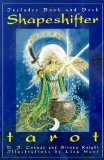
Shapeshifter Tarot
, by D. J. Conway and Sirona Knight, illustrated by Lisa Hunt
Llewellyn Publications, 1567183840
Before I began to read the book which accompanies this deck of cards, I took the opportunity to just skim through the 81 cards themselves. A couple of things struck me at once. One of these is the fact that there are a number of cards which do not correspond to the traditional Tarot deck (#21, #22, & #23 in the major arcane) and some rearranging of the court cards (the God of each suit corresponding to the Queen and the Goddess to the King of the traditional decks, plus the renaming of the suits. Then there are the suits themselves. The colours tend toward pastels, while the imaging is mythical in nature. While some may be slightly put off by these facts, I found them very beneficial.
The Descriptions and Prophecies contained in the book offer insights which come from a uniquely different perspective. They offer a Celtic-based interpretation unlike anything I have seen before. I don’t always agree with some of the ideas expressed by the authors, but their interpretations offer additional views into the world.
The rearranging of the highest two cards in each suit are dictated by the pre-eminence of the High Priestess (as representative of the Goddess) in many Pagan traditions, including that of the Gwyddonic Druid Tradition, while the swapping of swords (air in most systems) with wands (fire in most systems) is similarly influenced by the ritual style of working of that particular tradition.
Each of the suit cards is identified on the card, since the “traditional” symbols are absent from the actual image on the card. This absence makes for readings which have a much wider-ranging scope. Much of the traditional meaning is retained in this deck, through the forms used, but there is a lack of rigidity, and more of a feeling of fluid motion. When using these cards one is more aware of the changeable nature of our life experiences. One becomes more attuned to the fact that our olives are in flux, and that we CAN change what is forecast by changing ourselves. And isn’t that what divination is supposed to be about?
I have not had time to work at any depth with the layouts suggested, but from reading through them and meditating upon them, I must say they offer insights I had not experienced.
You could, of course, use a more “traditional” spread, or one of your own devising, so long as you are willing to make the mental shift to the more fluid meanings you are likely to find coming through these cards.
The appendices provide the correspondence between traditional decks and this deck, as well as a list of keywords.
I feel these cards would be an excellent deck for younger people. They would help them to avoid the pitfalls associated with many of the traditional decks (such as the association of Pentacles with money, and so on). They also should be good for meditation. You don’t NEED the book, but will find it an excellent explanation of the creation of this deck.








